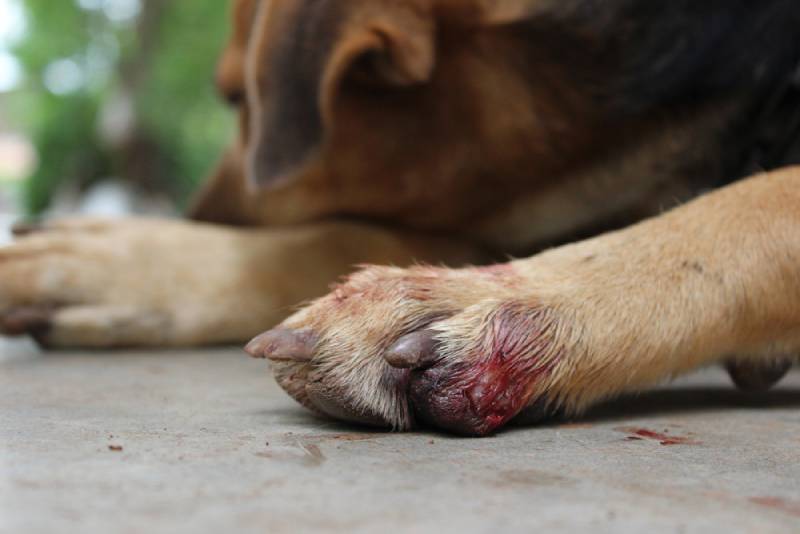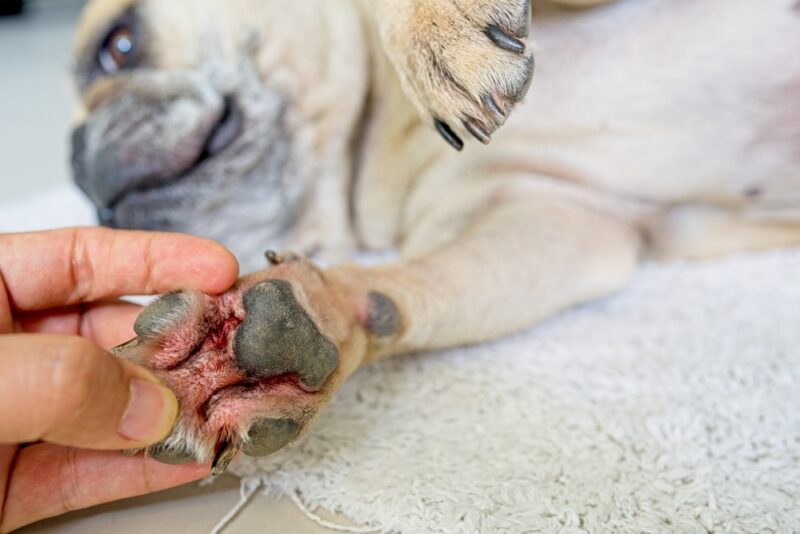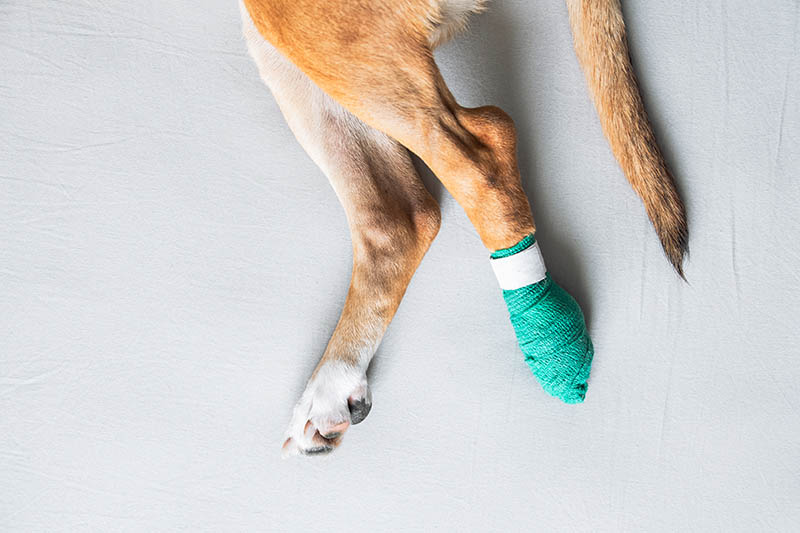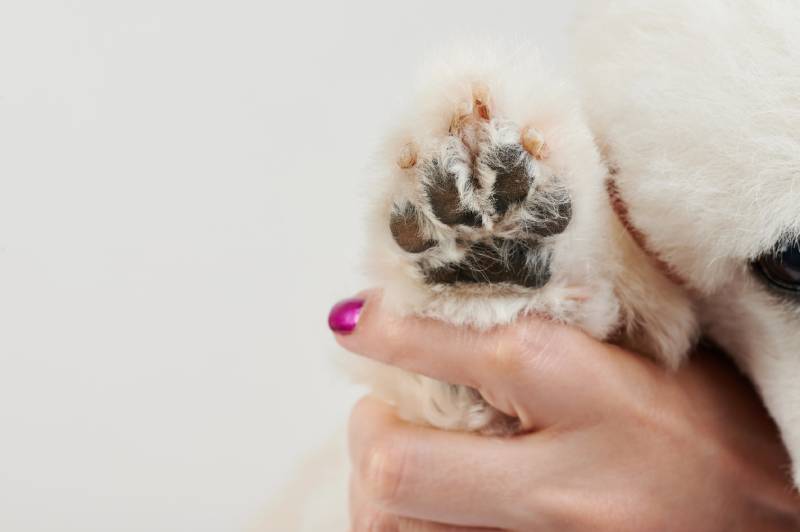Pododermatitis in Dogs: Signs, Causes & Care (Vet Answer)
By Dr. Kim Podlecki, DVM (Vet)
Updated on

Click to Skip Ahead
Pododermatitis is a condition most frequently seen in dogs versus cats. While there are many different causes of pododermatitis, it is frequently seen because of allergies and infection. Depending on the cause of the swelling, if there is an infection present, and if one or multiple feet are affected will help determine how your dog will be treated. The good news is that pododermatitis is a treatable and even curable condition.
What Is Pododermatitis?
Pododermatitis is inflammation of the feet. In dogs, this condition is frequently secondary to underlying allergies. Oftentimes the feet will also be infected, either on the skin surface, deep within the hair follicles and/or around the nail beds. Because allergies in dogs will manifest as itchy skin, dogs will lick, chew and bite at their feet, sometimes excessively. The normal bacteria from the skin and mouth, combined with the moisture of the saliva, creates a perfect breeding ground for infection.
The more your dog chews on the feet, the worse the infection, moisture, and inflammation becomes. The infection of the skin is extremely itchy, sometimes even more itchy than the underlying allergies themselves. This will then cause your dog to go after the feet even more, causing a snowball effect of irritation and swelling.
Pododermatitis, or swelling of the feet, may also occur from non-allergic causes such as immune-mediated disease, cancer, trauma and metabolic diseases. These all cause swelling of the feet for different reasons.

What Are the Signs of Pododermatitis?
The most obvious sign of pododermatitis is swelling of the feet. A dog can have one or multiple feet affected. Often the affected foot is uncomfortable and sometimes even painful to the touch from swelling. Your dog may be limping or hesitant to walk on the swollen feet as well, and may even nip at you if the feet are touched.
Pododermatitis is frequently secondary to allergies. Allergies in dogs will manifest as itching skin. Your dog will lick, chew and bite at the feet, causing infections to develop. This will cause the feet to be red, irritated, often smelly with discharge. You may feel your dogs’ feet and think they feel wet to the touch. This can be from them licking the feet and/or discharge from infection. Your dogs’ nails may appear brown or discolored from infection and some dogs will even lick the feet until there are open, weeping wounds.
If the feet are swollen from cancer, you may notice one or multiple lumps on the feet. Swelling from cancer may include the entire foot, or even travel up the leg towards other joints. Immune mediated disease that causes swelling may not be associated with any infections. You may notice just swollen feet, sometimes with hair loss, brittle nails and hair.
What Are the Causes of Pododermatitis in Dogs?
As discussed above, pododermatitis is frequently seen associated with allergies and secondary infection. The infection can be caused by yeast, bacteria, or both. If the bacterial infection is on the skin, this is known as pyoderma. There is the possibility that the pyoderma becomes so severe, it’s classified as deep pyoderma. Either way, a bacterial infection is involved.
With allergies, the feet initially become swollen from the trauma of the dogs licking their feet. The licking from the underlying allergies will cause inflammation and redness. As infection sets in, this will cause additional swelling.
Cancer may cause swelling secondary to actual lumps, masses, or bumps. Other times cancers may affect lymphatic drainage, causing swelling. Other cancers can cause trauma to underlying bones, which will then cause swelling of the affected foot.
Immune-mediated diseases that can cause pododermatitis are not frequently seen in dogs. These are conditions where the body essentially attacks itself. The body can attack its own blood cells, platelets, hair follicles and more. As this occurs, you may notice generalized swelling of the feet. Sometimes hair loss is present in the absence of infection. In other words, no discharge, odor, redness or wetness.

How Do I Care for a Dog with Pododermatitis?
Treatment and care can vary greatly, depending on the cause of the swelling. First things first, make an appointment with your veterinarian to try and diagnose the cause of the pododermatitis. If your dog is licking, chewing, or biting at the feet, placing an e-collar on them to help prevent further trauma is recommended. The less your dog bothers the feet, the better. Placing socks or wraps on the feet are not recommended unless specifically recommended by your veterinarian. Some wraps, if placed incorrectly, can actually make swelling worse or even cut off circulation.
Keep your dog off of hot or cold surfaces such as black top, ice, and also be wary of salt used for snow. All of these can cause additional irritation.
Medication
If your dog is diagnosed with allergies, your veterinarian will likely want to start long term medications to help control the itching and swelling. Secondary infections are often treated with oral antibiotics, topical medications and medicated shampoos. Oftentimes infections need to be treated for weeks until they clear and may recur as allergies are a lifelong battle.
Immune mediated diseases are all treated differently. In general, high doses of immunosuppressant medications are needed for control. There are numerous different types of immunosuppressant medications, and your veterinarian will decide which ones may be best on a case by case basis.
Surgery
If your dog has cancer that is causing the swelling, your veterinarian will discuss if surgery is an option or not to remove any tumors. They will discuss treatment options based on your dogs’ exact cancer or potentially refer you to a Board Certified Veterinary Oncologist for treatment options.
In general, pododermatitis can be a very uncomfortable condition. At minimum pain medications and some type of anti-inflammatory should be prescribed to help your dog while they are healing.

Frequently Asked Questions (FAQ)
Can Pododermatitis Be Cured?
Yes! Pododermatitis can be treated and cured. However, the underlying cause of pododermatitis may not be a curable condition. Immune-mediated diseases, allergies, and some cancers are lifelong diseases. They may be treatable and can be controlled, but they may not be able to be cured.
How Is Pododermatitis Diagnosed?
Your veterinarian will examine the feet for any signs of cancer, infection, broken nails, and trauma. They will then take a detailed history to determine what the possible cause for the swelling may be. Bloodwork, radiographs of the affected foot, and skin testing to look for parasites and infection may also be completed.
Final Thoughts
Pododermatitis refers to swelling of the feet. In dogs, this is frequently seen from allergies and infections. However, other causes such as cancer, immune-mediated diseases, and trauma may also cause pododermatitis. Your veterinarian will perform a complete physical and diagnostics to determine the cause of the swelling and then treat it accordingly. While pododermatitis can be treated and even cured, the underlying catalyst for the swelling may be a lifelong disease that has no cure.
Featured Image Credit: Mrs.Rungnapa akthaisong, Shutterstock















